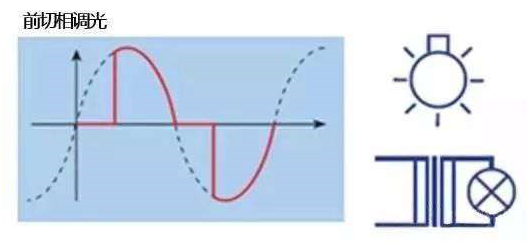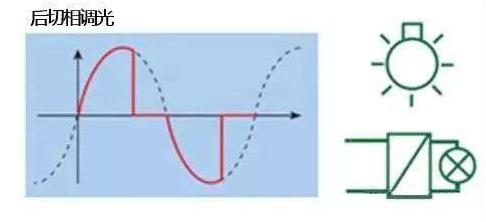With the development of technology, more and more things can be done on a mobile phone, ranging from a Ipon dimming system to a desk lamp, all can be dimmed using a mobile phone. In a space that needs dimming, designers need to understand which light sources can be easily dimmed and what dimming methods are available, so as to better provide solutions.
With the development of technology, more and more things can be done on the mobile phone, ranging from a dimming system to a desk lamp, all can be dimmed with a mobile phone. In a space that needs dimming, designers need to understand which light sources can be easily dimmed and what dimming methods are available, so as to better give a plan.
One, leading edge phase cut control dimming Principle:
Leading edge dimming is to use a thyristor circuit, starting from AC phase 0, the input voltage is chopped, and there is no voltage input until the thyristor is turned on. That is, the leading edge is turned on and the light is turned off naturally at the zero crossing point for dimming.

The front-end dimmer of LED fluorescent lamp power has the advantages of high adjustment accuracy, high efficiency, small size, light weight, and easy remote operation. It is dominant in the market, and most manufacturers' products are this type of dimmer. However, the front-cut dimmer is prone to produce a lot of noise, and this dimming method is not recommended for high-demand occasions.
Two, trailing edge phase cut control dimming Principle:
The rear edge dimming of the LED fluorescent lamp power supply adopts a triode circuit, and the dimmer chops the input voltage waveform. Turn off from one phase, and turn on at 180 degrees.

LED fluorescent lamp power trailing edge dimming: the MOS/IGBT technology of zero-crossing turn-on and trailing edge turn-off solves the problems of grid interference and noise.
Compared with the leading edge tangential control dimming method, the trailing edge tangential control dimming has better compatibility, but the internal circuit structure is more complicated and the control cost is relatively high.
Three, 1-10V dimming Principle:
The principle of 1-10V dimming mode can correspond to the following figure. The relationship between the control voltage on the abscissa and the luminous flux on the right ordinate is: when the control voltage is 1V, the luminous flux is at least about 1%, and when the control voltage is 10V, the luminous flux is at most 100%. In this dimming process, the relationship between the two is linear.

For example: there are many lights in a room, we equip each light with a set of 1-10V control line less than 50 meters, and connect it to the controller. When the controller adjusts, the voltage on the control line changes accordingly, and the light is also dimmed or dimmed.
The disadvantage of 1-10V dimming is that multiple groups of lamps on a control panel can only be changed at the same time. If you want to achieve different controls for each lamp, you can only make the control panel and the lamps one-to-one correspondence. When there are more, it will obviously become very troublesome to operate.
Four, DALI dimming(dali dimmer&dali drivers) Principle:
When facing multiple lamps and lanterns that need to be dimmed, we can use DALI dimming(dali dimmable led driver) to replace the 1-10V dimming method. DALI dimming is a typical digital control method.
DALI (Digital Addressable Lighting Interface) is an international public standard lighting control communication protocol with a communication speed of 1200 BPS ± 10%. Mainly used for dimming control of multiple fluorescent lamps and LED lighting. DALI dimmer can form a network with a maximum of 64 short addresses and 16 group addresses. A master can control one or more slaves to communicate in half-duplex mode.

The four letters of DALI have their own meanings:
Digital
Addressable
Lighting
Interface
DALI can dimming each lamp equipped with DALI driver&dali led driver. Different lighting units on the DALI bus can be flexibly grouped to achieve different scene control and management.
Compared with other dimming methods, the advantages of DALI dimming&dali dimmable led are:
1. Digital dimming, accurate, stable and smooth dimming;
2, DALI can communicate in two directions, and can feedback the status of the lamps to the system;
3, DALI control is more flexible;
4, DALI has strong anti-interference ability.
Copyright © 1998 ~ 2024 IPON General Electric Industry Co.Ltd. | All Rights Reserved 
Hello, please leave your name and email here before chat online so that we won't miss your message and contact you smoothly.